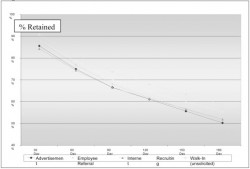 Analytics is a hot idea that will likely be topical for a decade more, much like competencies and employment brand were (and are). The best selling book on the subject is Thomas Davenport’s Competing on Analytics. The term “analytics” — if you want a really sophisticated definition — just means “let’s crunch some numbers.” One of the reasons it’s topical is that our internal systems are capturing far more numbers than ever before.
Analytics is a hot idea that will likely be topical for a decade more, much like competencies and employment brand were (and are). The best selling book on the subject is Thomas Davenport’s Competing on Analytics. The term “analytics” — if you want a really sophisticated definition — just means “let’s crunch some numbers.” One of the reasons it’s topical is that our internal systems are capturing far more numbers than ever before.
In recruiting, to the extent analytics have been used, the focus has been on internal recruiting processes. Recruiting departments want to reduce cost-of-hire and time-to-fill and thus may apply some number-crunching to find where they can make improvements. However, the big payoff comes when recruiting can affect operations by improving quality of hire. The recruiting function needs to make the effort to shift its focus from the comfortable world of its own operations and instead spend more time in partnership with the business units to see how recruiting can make a difference there.
Nowhere is analytics more important than in the recruitment of front-line workforces. Robert Yerex, chief economist at the workforce-management vendor Kronos, points out that in many industries the number of front-line workers is so large that you can easily get enough data for sophisticated analysis, and even small improvements add up to very large savings. The recruiting function is a particularly important part of HR for the front-line workforce because these workers typically don’t stay that long. The organization is counting on recruiting to get people who hit the ground running and fit sufficiently well that they don’t leave after the first few weeks. If recruiting fails at this then it creates a huge cost for the organization.
There are many ways analytics can help recruiting functions improve the quality of front-line workers (and we’re getting into details in the April 2009 issue of the Journal of Corporate Recruiting Leadership). Let’s just look at one (as shown in the graphic above as an example) to give you a flavor.
A simple analysis of retention by source of hire can show recruiting how they should aim its sourcing efforts and even lead to quantifying how much extra value one source creates compared to another due to higher retention. This analysis might completely overturn conclusions of a typical cost per hire analysis since retention can be so valuable to a company that it overwhelms the different in cost in using a particular source.